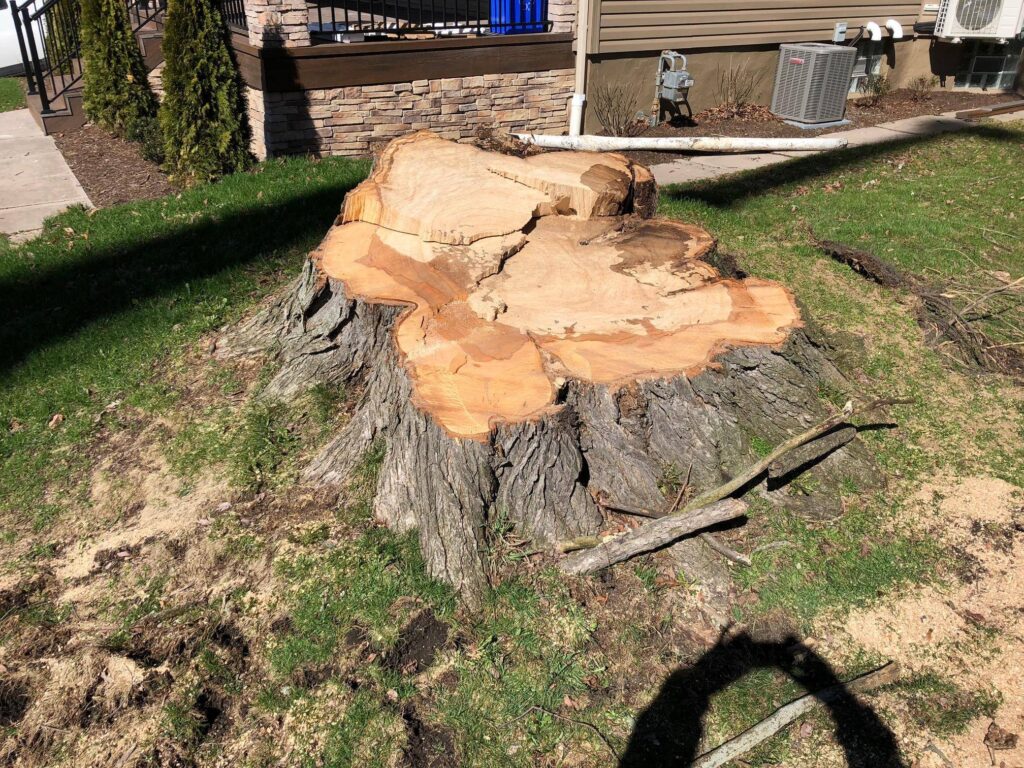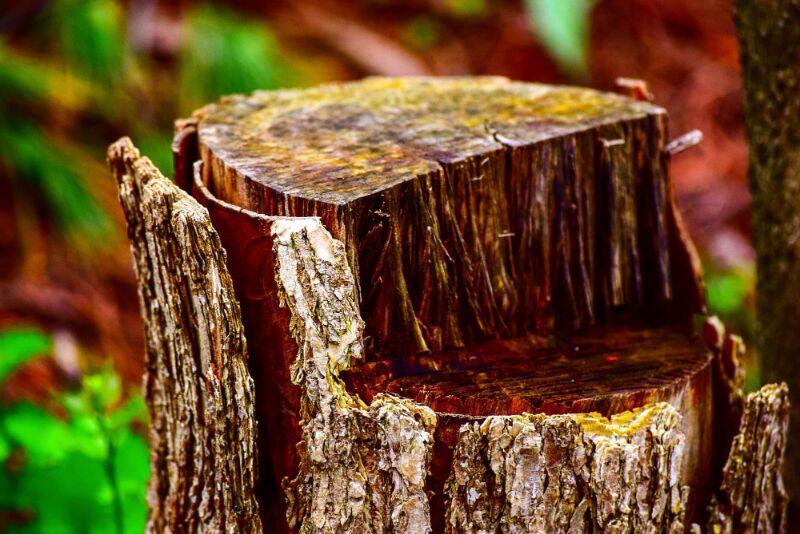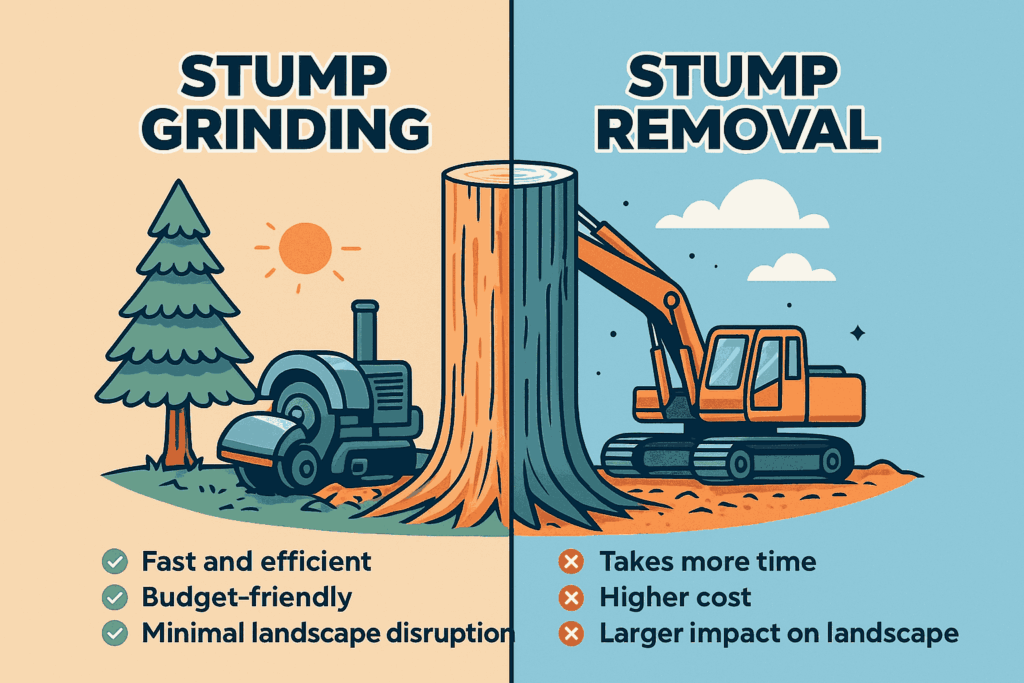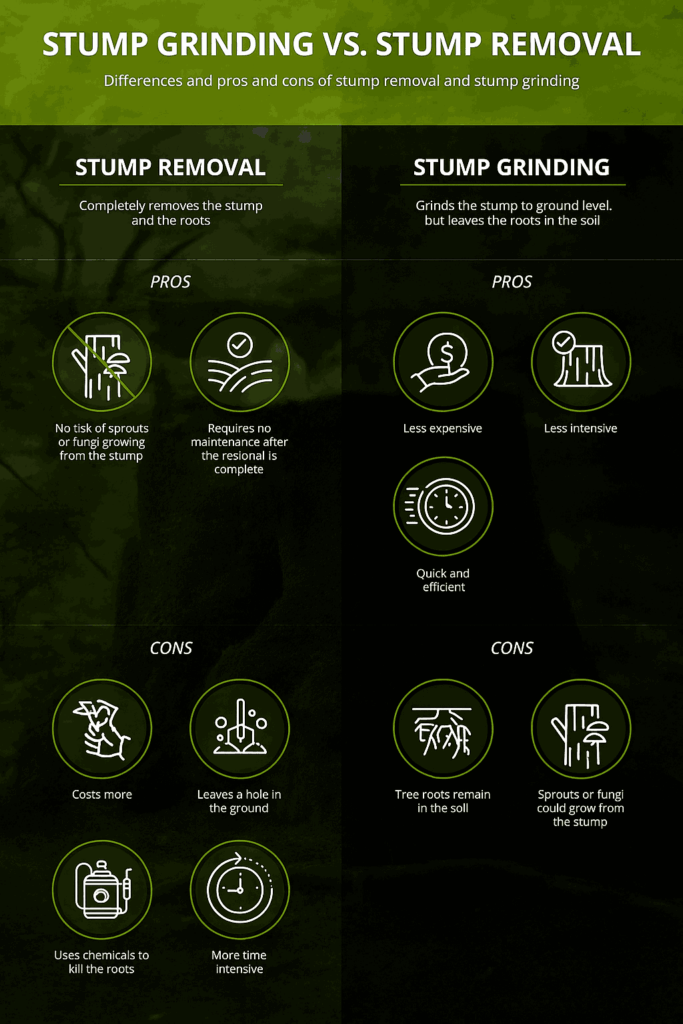When a tree is felled, the resulting stump can be more than just a nuisance. It may invite insects, disturb landscaping, or even create trip hazards. Homeowners and property owners are left asking: do you grind out the stump or take it out completely?


What Is Stump Grinding? (Quick & Cost-Effective Method)
Stump grinding uses self-propelled grinders with spinning carbide teeth to break the wood apart. They usually grind the stump six to twelve inches below ground, though deeper cuts are possible if requested. Afterward, you’re left with wood chips or sawdust, level with the soil or slightly sunken.
Timing depends on size and density: small stumps may take half an hour, larger ones several hours. It’s a mechanical job; effective at getting rid of the visible stump. It’s a mechanical job; loud, messy, but highly effective at getting rid of the visible stump.

Figure 1. Professional stump grinding results showing a cleanly cut tree stump flush with ground level, demonstrating the precision and quality workmanship achieved by Blooma Tree Experts’ grinding services
What Is Stump Removal? (Complete Root System Elimination)
Stump removal involves removing the whole stump with most of its root mass. It involves heavy equipment such as excavators or backhoes, along with chainsaws or hand tools, Excavation usually goes out three to eight feet from the trunk, depending on the species.
Large structural roots are taken out, although smaller feeder roots can be left behind. The process creates a big hole that needs to be well backfilled. Each stump takes three to eight hours, depending on size and complexity. It is a guaranteed full clearing. Most homeowners opt to contract to do the job. It is a hard, noisy, and messy process but guarantees full clearing.

Figure 2. Complete stump removal by Blooma team showing heavy excavation work with the entire root system and stump lifted from the ground, demonstrating thorough extraction that leaves the area ready for replanting or construction.
Stump Grinding vs Removal: 7 Critical Differences Compared
1) Depth and Scope Differences
Stump grinding is 6–12 inches below grade, sufficient to level the area. Stump removal excavates three to eight feet, removing the root ball and system
2) Equipment Requirements: Light vs Heavy Machinery
Grinding employs machines with rotating teeth that reduce wood to mulch. It’s technical but fairly simple with proper training.
3) End Result Differences
Grinding leaves chips and a root matrix that may sprout again, though you can re-seed immediately. Removal leaves a big hole that needs to be filled and restored.

Figure 3. Heavy excavation for removal (right) versus lighter grinding machinery (left) in action
Cost Analysis: Grinding vs Removal (40-60% Savings Breakdown)
Stump grinding is the more affordable option, averaging $75–$400 per stump, while complete removal ranges from $150–$800. This represents a 40–60% savings for grinding, but the lower upfront cost comes with some long-term trade-offs.
1) Grinding Cost Breakdown (Per-Inch Pricing Guide)
Professional grinding is generally between 2 and 5 dollars per inch of stump size, which is affordable when you have a number of stumps. Self-service rentals are between 200 and 400 dollars per day and can include a few stumps, provided that you are willing and capable of doing the work.
2) Removal Cost Breakdown (Equipment & Labor Included)
Removal services generally cost $150–$800 depending on stump size and site accessibility. For DIY attempts, an excavator rental runs $300–$500 per day plus disposal fees.
Time Investment: How Long Each Method Actually Takes

Figure 4. Blooma Tree Professional expertly operating a high-powered stump grinder on a large tree stump, efficiently converting the entire stump into valuable wood chip mulch while creating a perfectly smooth and level yard surface ready for immediate landscaping or lawn restoration.
1) Grinding Time Factors
Grinding is the quicker process, with most stumps taking around an hour on average. Small stumps less than 12 inches can be done in 30–60 minutes, and medium ones (12–24 inches) take more like 60–90 minutes. Large stumps over two feet in diameter can take two or three hours. Setup and preparation, like placing the grinder and removing debris, take an additional 15–30 minutes. Overall, grinding is effective when speed and surface-level clearing are the concerns.
2) Removal Time Factors
Removal is much more labor-intensive, with an average time of five hours per stump. Small stumps are two to four hours, medium are four to six hours, and big stumps are six to eight hours, especially where there are complex root systems. Utilize a timeline planning guide for efficient maintenance.
Advantages and Disadvantages: Grinding vs Removal

Figure 5. Complete stump removal exposing the full root system for a clear, replant-ready yard.
Stump Grinding vs Complete Removal Comparison
Factor Stump Grinding Complete Removal Cost $75 – $400 per stump $150 – $800 per stump
(40-60% more expensive)Time Required 30-90 minutes 3-8 hours per job Site Disturbance Minimal disruption More invasive process Equipment Access Small, portable equipment Heavy equipment required Weather Dependency Less weather dependent Highly weather dependent Root Removal Shallow roots only
Risk of regrowth95-99% of roots removed
No regrowthReplanting Difficult in same spot Immediate replanting possible Best For Quick, economical solution
Limited access areasPermanent solution
Future construction/utilities
1) Stump Grinding Advantages
From a technical point of view, stump grinding is much more economical, with costs ranging from $75 to $400 per stump, which is considerably less than full removal of a stump. The work is rapid; the majority of the jobs are done in 30 to 90 minutes. Because grinding does not require deep excavation, site disturbance is minimal and the site can be ready for turf right away. Another benefit: the resulting wood chips, with a value of $50 to $150, can be utilized as mulch. The equipment used is small and portable, which is well-suited for sites with limited access.
2) Stump Grinding Disadvantages
Poplars and willows, which are infamous for their aggressive return from the roots, will readily resprout within a short time after initial removal attempts. Exposed root systems that remain hinder replanting in the same spot almost entirely and can make future landscaping designs problematic or even threaten buried utilities. Ordinary grinding methods only scrape the more shallow, structural roots and leave latent problems untouched.
3) Complete Removal Advantages
If full removal is the goal, stump removal is the clear choice. This treatment removes 95–99% of stump and root mass, leaving the site ready to replant, build, or install utilities immediately. Since no roots are left to grow back, potential future problems are eliminated.
4) Complete Removal Disadvantages
Removal is 40–60% more expensive than grinding, at $150 to $800 per stump. The process of removal is physically demanding, usually taking anywhere from 3 to 8 hours per job. The job requires heavy equipment, which in turn isn’t always convenient to use in confined areas. Moreover, the procedure is extremely weather dependent; water-saturated or frosty ground can bring work to a grinding halt. Although removal is more invasive and costs more, it does provide an all-encompassing, long-term solution as opposed to partial measures.
What Happens to Roots: The Critical Difference
Stump grinding and removal vary most dramatically in their approach to root systems. Stump grinding leaves 80–90% of the root mass in place under the ground, so the structural roots of the tree are still there and, in some trees, can result in future sprouting. Full removal removes 70–80% of the root system, removing the large structural roots and leaving little regrowth potential.
1) Decomposition and Soil
Through grinding, the remainder of the roots is allowed to break down naturally in three to seven years, a long process that saves the underground system but can complicate future soil utilization. Removal, in contrast, produces an initial void that must be filled with soil, graded, and compacted before the land is again usable.
2) Utilities and Replanting
The choice also affects long-term land use. Persisting roots from grinding can lead to issues with future underground utility work and prevent planting a new tree in the exact location. Removal clears the location entirely, allowing for immediate replanting or construction without underground obstacles.
When Each Method Makes Sense (Application scenarios)
Grinding leaves approximately 80–90% of the root mass in the ground. Roots will naturally break down in three to seven years but, in some tree species, can cause regrowth. In addition, remaining roots can make future underground utility connections problematic. So if you need a cleared subsurface for utilities or want to seed right away, removal is the more conservative option, as it clears 70-80% of the root mass.
1) Choose Stump Grinding When
Grinding is the route to take if speed, affordability, and surface-level augmentation are what you’re after. It is ideal for lawn restoration, clearing several stumps economically, or in spaces where heavy equipment won’t fit.
2) Choose Stump Removal When
Removal is more suitable for long-term or intensive land use. If you must replant where it was before, prepare the area for utilities, or work with tree species that are notorious for violent regrowth, removal of the whole stump is usually the way to go. It takes more time and disturbs the site more but kills all of the roots, so you won’t have problems in the ground later on. Professional services are always recommended for complete removal.
Environmental and Site Impact Differences
Stump removal and grinding have significantly disparate environmental and operational effects. Stump grinding, on the other hand, provides 2 to 4 cubic yards of wood chips for a big stump; these can be utilized as on-site mulch, which is inexpensive. Total removal generates much more waste, usually 10 to 20 cubic yards of removed root material and soil. Off-site disposal must be arranged, resulting in both project logistics and environmental impact.

Figure 6. Exposed underground stump surface shows how removal disturbs soil and disrupts microbial layers (Image credits: greendrop.com)
1) Soil and Equipment
Grinding is comparatively non-intrusive. It barely moves any soil, and only requires small equipment that is easily manageable. Stump removal, however, requires the use of heavy equipment during the excavation, which increases the amount of disturbance of the ground and the area covered.
2) Landscape and Restoration
Grinding tends to leave nearby plantings intact and leaves the area available for use immediately, be it for seeding grass, sod, or light landscaping. Wholesale elimination, however, usually kills the vegetation around, and leaves a large hole. Before this excavation area can be reintroduced into the landscape, it needs to be filled, compacted and replaced.
Making Your Decision: Grinding vs Removal

Figure 7. Choose light grinding or heavy excavation based on site requirements
1) Intended Site Use
Begin at your finish point. If appearance is your priority and there is no construction or replanting planned, stump grinding will usually be enough. On jobs involving undisturbed ground; such as the installation of utilities, new building, or planting a replacement tree, complete removal is required to remove all the root system.
2) Cost Analysis
Grinding typically costs 40-60 percent lower than the total removal cost. Although it is the cheaper option in the short-term, removal gets rid of the risk of regrowth and future root interference, which could mean that overall future costs are reduced, particularly when you intend to do further work on the site.
3) Project Timeline
With grinding, majority of stumps can be dealt with in a couple of hours. Removal takes longer, however, and can take a whole day per stump, depending on diameter and root intricacy. The trade-off is between speed and permanence.
4) Site Constraints
Access limitations and the presence of underground utilities can dictate your method. Grinding equipment is compact and suitable for tight or restricted spaces. Full removal requires larger machinery and more clearance, and often involves pre-work utility location to prevent damage.
5) Expert Consultation
A complex location or big project is supposed to be evaluated professionally. Get detailed estimates that include equipment requirements, manpower, waste disposal, restoration of the site, and expected project schedules to prevent cost surprises, delays.
Grinding is quick and non-destructive, but has long-term restrictions because of retained roots. Clearance gives a fresh start but means extra soil preparation and site work. Your decision should fit your project scope, site factors, and plans for future land use. More information on grinding options is available in our stump grinding services. Professional grinding typically runs $2–$5 per inch of stump diameter, making it cost-effective for multiple stumps.

Figure 8. Infographic comparing stump grinding and stump removal, highlighting key pros and cons of each method.
Frequently Asked Questions (FAQs)
1. Is it cheaper to grind or remove a stump?
Stump grinding is less expensive, yes. The cost of grinding is between $75 and $400 per stump, and total removal costs are between $150 and $800 per stump. Grinding consumes approximately 40-60% less energy than removal and is the less expensive choice when you do not require complete removal of the root.
2. What is the main difference between stump grinding and removal?
- The stump grinding removes the stump 6-12 inches below ground level while roots are left behind.
- Stump removal entirely removes the stump and large root system (3-8 feet out) leaving a clean area to replant or build.
3. Can a tree grow back after stump grinding?
In some cases, yes. Because the root system is not removed when the ground is disturbed, some species (such as willows and poplars) can develop new shoots. In the long run, it is advisable to remove the stump completely.
4. Does stump grinding leave a hole?
Not typically. The stump grinding leaves behind wood chips which typically fill the hollow left behind by the stump. You may have a little depression to it, but it can be easily filled in with topsoil or mulch. Removal, on the other hand creates a big hole which needs backfilling.
5. Can you get rid of a tree stump without grinding it?
Yes. Options include:
- Full removal of stumps, excavated.
- Chemical procedures to accelerate decay.
- Burning (not suggested because it is unsafe and hazardous to the environment).
- Small stumps to be removed by hand tools.
6. Does stump grinding remove roots?
No. It just grinds down the stump below ground level. The large root system (80-90%), remains underground and will naturally decay between 3-7 years. Most of the roots are pulled out.
7. Which method is faster: stump grinding or removal?
It is much faster to grind, 30 minutes to 2 hours per stump, depending on size. Large stumps with complex roots may not be removed in less than 3-8 hours.
8. Which is better for replanting: stump grinding or removal?
You should remove the stump so that you may plant another tree in the same location. Grinding causes root growth that makes it difficult to replant and removal leaves the soil totally bare.
9. What happens to the wood from stump grinding?
The grinding yields 2-4 cubic yards of wood chips per big stump. You can leave these on-site as mulch, or you can spread them on your property, or you can have them transported off at an extra cost.
10. When should I choose stump grinding instead of removal?
Grinding is best when you:
- Need an inexpensive and fast way.
- Do not intend to replant there.
- Prefer not to disturb your landscape.
- Inaccessible to large excavation machinery.
11. When should I choose stump removal over grinding?
Removal is best when you:
- Intended to replant the same site.
- Must have a construction-ready location (foundation, driveway, utilities).
- Need a permanent one and with no chance of growing back.
- Dealing with aggressive root systems.
12. Can I do stump grinding or removal myself (DIY)?
Yes, but with caution:
- Home grinding involves hiring a stump grinder (200-400 pounds of money a day). These are high-powered machines that need safety equipment.
- Do-it-yourself removal often requires a heavy machine (excavators, backhoes) that is expensive and more difficult to run.
- To the average house owner, a professional is safer and more effective.







